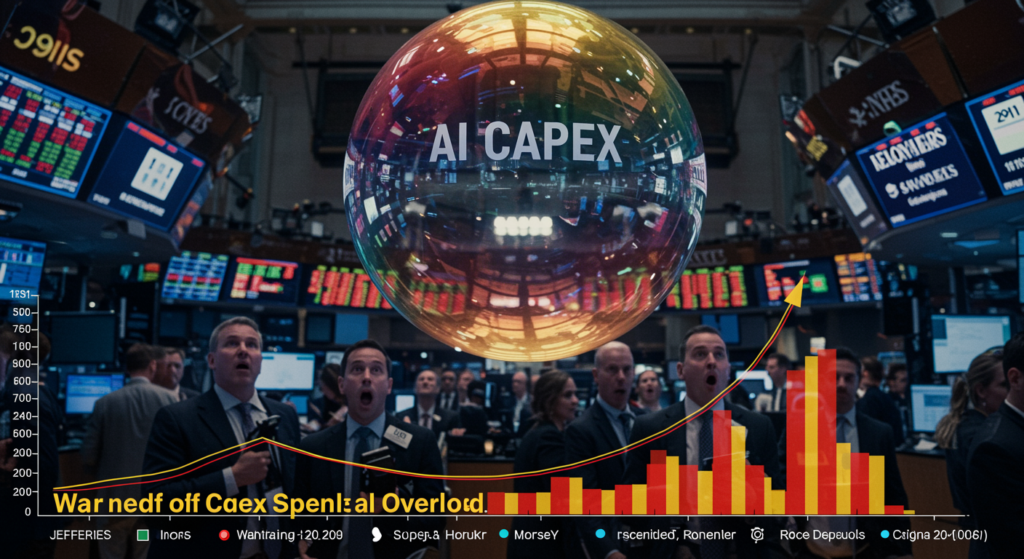
AI Capex Overload: Jefferies Warns of Excessive AI Spending
Understanding the Surge in AI Capex Overload
In the fast-evolving world of AI, we’re seeing an explosive rise in investments that could lead to AI Capex Overload. Tech giants are betting big on artificial intelligence, channeling hundreds of billions into building out infrastructure that promises to reshape industries. But as Jefferies points out, this aggressive capital expenditure—or Capex—might be pushing the envelope too far, raising questions about long-term viability and real returns. Have you ever wondered if all this spending will pay off, or if we’re heading toward a tipping point?
The drive stems from fierce competition among companies like Google and Amazon, each racing to dominate AI’s future. Jefferies’ analysis highlights how this rush is not just ambitious but potentially risky, with investors starting to scrutinize whether these massive outlays will translate into profits. For instance, while AI innovations are exciting, the sheer scale of investments could overwhelm markets if demand doesn’t keep up.
Think about it: AI Capex Overload isn’t just about numbers; it’s about the broader implications for innovation and economy. Analysts predict that without careful planning, this could mirror past overinvestments, leaving companies with underutilized assets and strained finances. To avoid this, firms need to balance ambition with realistic projections, ensuring their AI strategies are grounded in sustainable growth.
Jefferies’ Perspective: A Growing Bubble in AI Capex Overload
Jefferies has been vocal about the emerging bubble tied to AI Capex Overload, warning that unchecked spending could inflate valuations beyond what’s sustainable. Even with stellar revenues from players like Meta and Nvidia, the real challenge lies in turning these investments into profitable outcomes. It’s a scenario where short-term gains might mask deeper issues, prompting investors to rethink their positions.
- Global AI server investments are forecasted to hit $400–500 billion from 2023 to 2025, a figure that underscores the scale of AI Capex Overload.
- Power costs for AI data centers alone could reach $27 billion annually, adding to the financial burden without immediate returns.
- While tech firms boast strong cash flows, the uncertainty around return on investment (ROI) is what keeps experts like Jefferies on edge.
As we dive deeper, it’s clear that AI Capex Overload might expand before any correction hits, especially since companies aren’t rushing to issue new equity. This creates a delicate balance: optimism fuels growth, but without solid monetization plans, 2026 could bring tough questions. What if the bubble bursts? Investors might face significant losses, making it crucial to monitor these trends closely.
To put this in perspective, imagine a tech company pouring billions into AI hardware only to find the market saturated. Jefferies advises focusing on metrics like ROI to navigate this landscape effectively. By doing so, you can spot opportunities while sidestepping potential pitfalls in AI Capex Overload.
The Risks of Overbuilding in AI Capex Overload
One major concern in AI Capex Overload is competition neglect, where companies underestimate rivals’ moves and end up overbuilding infrastructure. This isn’t new—history is full of similar stories, like the railroad booms that left excess capacity and depressed earnings for years. In today’s AI race, multiple firms expanding at once could lead to a glut of resources that no one fully utilizes.
“Heavy investment during booms predictably depresses future earnings and the price of capital, leading prices to overshoot their rational-expectations levels.” — Greenwood & Hanson, 2015
This “big market delusion” often tricks leaders into thinking everyone will win, but reality paints a different picture. For example, if two AI giants build identical data centers simultaneously, the resulting overcapacity could drive down costs and profits for both. To counter this in AI Capex Overload, businesses should conduct thorough market analyses and collaborate where possible, rather than charging ahead blindly.
Historical Parallels: Learning from Past AI Capex Overload Scenarios
- Dot-Com Boom: Companies poured money into internet ventures without clear profits, leading to a crash that wiped out billions.
- Housing Bubble: Overinvestment in real estate created a surplus that triggered a financial crisis, teaching us about the dangers of excess.
- Railroad Era: Parallel investments outpaced demand, resulting in long-term losses that echo the risks of today’s AI Capex Overload.
These examples show why addressing AI Capex Overload early is key. By studying them, investors can adopt strategies like diversifying portfolios or prioritizing projects with proven demand. After all, what’s the point of innovation if it doesn’t lead to sustainable success?
AI Monetization Challenges Amid Capex Overload
At the heart of AI Capex Overload is the struggle to monetize these investments effectively. Jefferies estimates that the industry needs over $100 billion in new AI revenue just to achieve a modest 10% after-tax return. Without clear business models, all that spending might not yield the expected fruits, leaving companies in a bind.
| Factor | Current State | Challenge |
|---|---|---|
| Capex Spending | $400–500B (2023–2025) | Risk of overcapacity in AI Capex Overload, heightening financial exposure |
| Operational Costs | $27B/year (power costs) | Eroding margins and complicating ROI in AI Capex Overload |
| Monetization Visibility | Low | Delayed profitability, a core issue in AI Capex Overload dynamics |
| Investor Sentiment | Optimistic yet cautious | Potential for market shifts tied to AI Capex Overload concerns |
Facing AI Capex Overload, companies must innovate revenue streams, such as subscription-based AI services or partnerships. A practical tip: Start small with pilot projects to test monetization before scaling up. This approach could help mitigate risks and turn AI Capex Overload into a manageable challenge.
Market Response to the AI Capex Overload Wave
Stocks in the AI sector are soaring despite these concerns, with Nvidia and Microsoft riding high on investor enthusiasm. Yet, events like the rise of new competitors such as DeepSeek are injecting volatility, forcing a reevaluation of valuations amid AI Capex Overload. It’s a reminder that hype can only go so far without solid fundamentals.
Jefferies urges caution, particularly in the semiconductor space, where supply chain disruptions could exacerbate AI Capex Overload issues. For investors, this means keeping an eye on key indicators like earnings reports and market trends. Here’s a question: How are you preparing your portfolio for potential shifts in AI spending?
Future Outlook: Will AI Capex Overload Lead to a Burst?
Jefferies paints a mixed picture for AI Capex Overload—it’s growing, but not necessarily doomed. In the short term, well-funded companies will likely continue investing, buoyed by AI’s potential. Medium-term, though, increased scrutiny on ROI could spark adjustments, and long-term, we might see a shakeout where only the most efficient players thrive.
- Short-Term: Expect more AI Capex Overload as hyperscalers push forward with expansions.
- Medium-Term: Investor doubts could intensify, testing the resilience of AI Capex Overload trends.
- Long-Term: A possible realignment, where unsustainable investments in AI Capex Overload falter.
To navigate this, focus on due diligence and seek out firms with clear monetization paths. Remember, AI’s transformative power is real, but so are the lessons from history.
Conclusion: Steering Through AI Capex Overload
AI Capex Overload serves as a cautionary tale in the tech world, where excitement meets uncertainty. While Jefferies’ warnings highlight potential bubbles, strategic planning can turn risks into opportunities. If you’re an investor, consider auditing your AI holdings and exploring diversified options—it’s about playing smart, not just big.
What are your thoughts on AI Capex Overload? Share in the comments, or check out our resources on AI Investing Strategies and Technology Stock Analysis for more tips. Let’s keep the conversation going!
References
- Video analysis on AI investment trends. Source: YouTube, https://www.youtube.com/watch?v=d7zfnGx7leY
- Discussion on massive AI spending. Source: Acadian Asset Management, https://www.acadian-asset.com/investment-insights/owenomics/massive-ai-spending
- Jefferies’ view on the AI bubble. Source: Investing.com, https://www.investing.com/news/stock-market-news/jefferies-says-ai-is-already-a-bubble-but-the-bubble-will-likely-get-bigger-432SI-3518176
- AI stocks and earnings lag. Source: India Dispatch, https://indiadispatch.com/p/ai-stocks-balloon-even-as-earnings-lag-jefferies-warns
- Broader AI market insights. Source: NextGen AI Today, https://nextgenaitoday.com/blog-post1
- Tech stock crash warnings. Source: Markets Insider, https://markets.businessinsider.com/news/stocks/tech-stock-crash-deepseek-magnificent-7-nvidia-outlook-valuation-capex-2025-1
AI Capex Overload, Jefferies AI warning, excessive AI spending, tech bubble risks, AI capital expenditure, AI investment bubble, AI spending concerns, Jefferies analysis, AI market risks, AI ROI challenges







